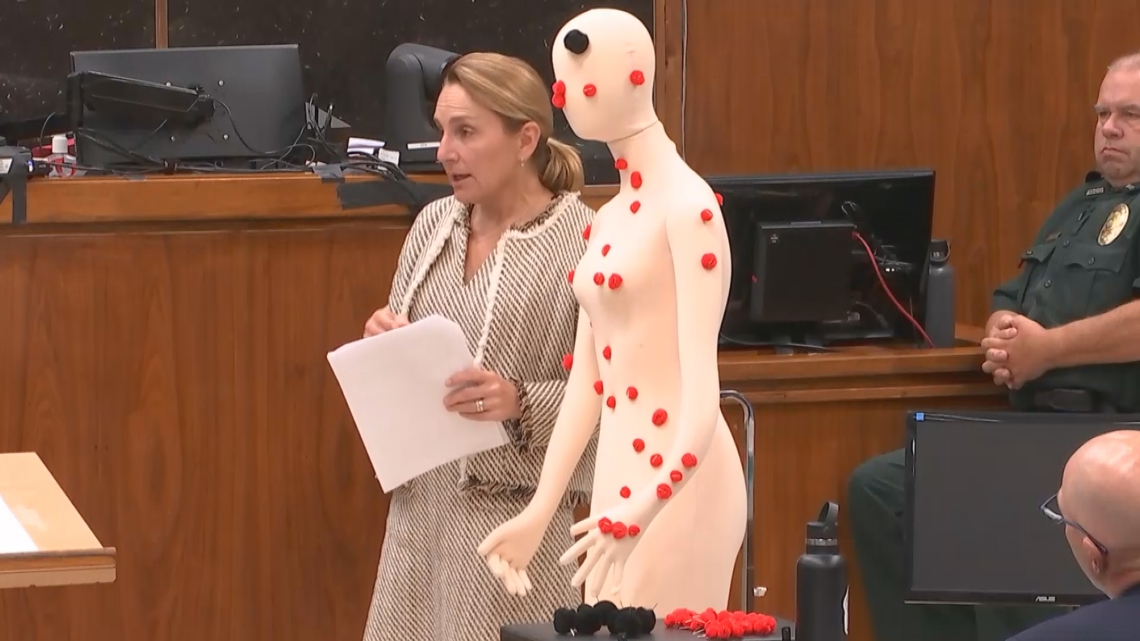ANDERSON COUNTY, Tenn. — Editor's Note (8/16): An earlier version of this story said the jury had entered deliberations around 3:45 p.m. That information was incorrect. This story has been corrected to reflect that the state had finished its closing arguments before 3:45 p.m. and that the defense would soon give its closing arguments after a court break.
Prosecutors wrapped up closing arguments Friday afternoon in Sean Finnegan's capital murder trial.
Judge Don Ash sent court into a 10-minute recess before the defense prepared to give its closing arguments. With the day drawing to a close, the jury is not expected to formally begin deliberating a verdict until Saturday.
--
On Thursday, the prosecution called a key witness to the stand in Sean Finnegan's capital murder trial.
Dr. Darinka Mileusnic-Polchan is the chief medical examiner for Knox and Anderson counties. Her office performed the autopsy on Jennifer Paxton's body in 2020.
Dr. Mileusnic-Polchan took the stand Thursday afternoon and remained there for several hours. She explained the autopsy in detail, as well as the various physical injuries Paxton sustained before, during and after her death.
Paxton suffered dozens of injuries — too many to count, she said.
Paxton's throat was slit, and her body had slices on her face, back, arms, wrists, hands, abdomen, pelvis and buttocks.
Her nose had been removed with a sharp knife, and the slices were "precise", Mileusnic-Polchan said. Paxton's left breast had also been cut out in a ring-like pattern around her nipple, Mileusnic-Polchan added. Paxton's right breast showed a similar slicing pattern, but it was not removed, as if it was "never finished" the doctor said.
Paxton also suffered deep slices into her abdomen. The cuts were haphazardly done, but very deep, Mileusnic-Polchan said.
The autopsy determined that Paxton's cause of death was ligature strangulation, meaning a rope or string had been used around her neck. The state asked Mileusnic-Polchan if a shoelace would be consistent with Paxton's injuries, and she said yes.
Mileusnic-Polchan used a foam mannequin and several red and black markers to show the jury where Paxton suffered injuries. While showing these injuries, several members of the jury were visibly uncomfortable, wincing and looking away.


Mileusnic-Polchan also showed 41 graphic autopsy photos of Paxton's body to the jury. Several jurors had a challenging time looking at the photos, having to look away or rubbing their eyes with their hands.
While the autopsy photos were being shown, Finnegan kept his gaze downward and looked at the floor. Throughout the trial, he has remained alert, showing no emotion, but watching and listening to witnesses.
Jennifer Millsaps is a TBI agent who helped examine the DNA evidence taken from Finnegan's home in 2020. She testified that a shoelace from a pair of black shoes found in Finnegan's bedroom contained the DNA from three individuals, including at least one male. But the DNA results were inconclusive when it came to connecting those profiles to actual people.
That TBI agent went into other details about the DNA evidence found at the crime scene.
Swabs from Paxton's vaginal area contained DNA from an unknown male. In the defense's cross-examination of Millsaps, they pointed out that that meant the DNA found was from another male that wasn't Finnegan, because they already had a profile of Finnegan's DNA.
The prongs of the choke chain found at Finnegan's house were also swabbed. No DNA was found.
The two dog leashes were also swabbed -- the results found the DNA of at least two individuals, including at least one male, but the results were inconclusive.
The metal chains found in Finnegan's home were tested as well. On one side of the chain, DNA from two individuals, including one male, was found, but the major DNA contributor was Paxton.
On the other side of the chain, the major DNA contributor was identified as Rebecca Dishman. Another contributor's DNA was also found, but couldn't be identified.
The inside of the freezer was also swabbed for DNA. Prosecutors say Finnegan kept Paxton in a freezer for eight months after her murder. Mileusnic-Polchan testified that the medical examiner's office had to thaw Paxton's body for several days in order to be able to conduct an autopsy, as she was frozen solid.
Paxton's hemoglobin, a component of blood, was found inside the freezer.
Her DNA was also detected in a swab from a stain near the fireplace in Finnegan's home.
Millsaps explained in her testimony that time, sunlight and cleaning agents can all break down DNA and make testing more challenging.
The state also called Daniel Miller to the stand. Miller is a sales and customer service representative at Rent-A-Center.
Miller testified that on Dec. 27, 2019, Sean Finnegan ordered a freezer to be delivered to his home. He instructed employees to leave the freezer on his front porch. They delivered it on Dec. 28, 2019. The prosecution argued Paxton was killed sometime around Christmas in 2019.
But in their cross-examination of Miller, the defense explained Finnegan's history with Rent-A-Center. They aimed to prove that Finnegan was a returning customer of the company and always made his payments on time.
The trial resumes Friday morning in Clinton. The state is expected to call just a few more witnesses.

